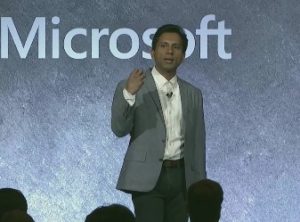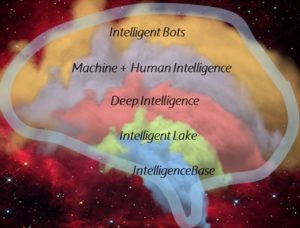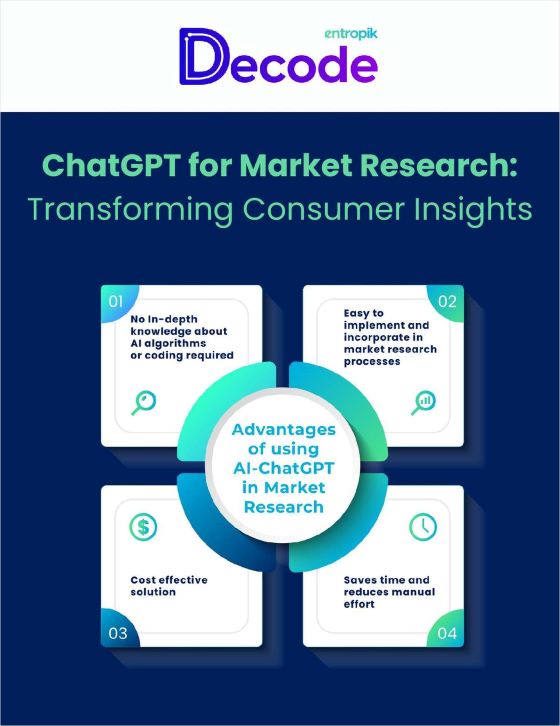 In this video from the Microsoft Machine Learning & Data Science Summit, Dr. Joseph Sirosh presents: Azure – the Cloud Supercomputer for AI.
In this video from the Microsoft Machine Learning & Data Science Summit, Dr. Joseph Sirosh presents: Azure – the Cloud Supercomputer for AI.
“We are still in the first minutes of the first day of the Intelligence revolution. In this keynote, Dr. Joseph Sirosh will present 5 solutions (and their implementations) that the intelligent cloud delivers. Join us in this keynote to learn how these solutions can help any organization, from a startup to an enterprise, better handle uncertainty, reduce risks, build intelligent applications that deliver better services faster, grow customer loyalty, help businesses become more proactive with respect to customer needs and differentiate themselves from intensifying competition.”
Sirosh shares five cloud AI patterns that his team and presented at the Summit.
A fun way to illustrate these patterns is to draw a loose parallel between our Intelligent Cloud vision and the anatomy of the human brain. These five patterns are really about ways to bring data and learning together in cloud services, to infuse intelligence.
1. IntelligenceBase
 This is the pattern where intelligence lives with the data in the database. Imagine a core transactional enterprise application built with a database such as SQL Server. What if you could embed intelligence, i.e. advanced analytics algorithms plus data transformations, within the database itself, to make every transaction intelligent in real time? That’s now possible for the first time with R and ML built into SQL Server 2016. At the Summit, we’ll illustrate this with a fascinating demo of real-time predictive fraud detection and scoring in SQL Server. The fraud scoring model lives inside the SQL Server, interprets signals from millions of real-time transactions, identifies fraudulent ones, and makes the fraud scoring results queryable and joinable with other database data. By combining the performance of SQL Server in-memory OLTP technology as well as in-memory columnstores with R and ML, applications can get remarkable performance in production, as well as the throughput, parallelism, security, reliability, compliance certifications and manageability of an industrial strength database engine. This power is fully available in the hybrid cloud – with SQL VMs in the cloud or on-premises. Joining us to showcase this pattern are two customers, PROS, who are using ML for revenue management in a SaaS app on Azure, and Jack Henry, who will be using ML for their loan scoring and customer churn prediction.
This is the pattern where intelligence lives with the data in the database. Imagine a core transactional enterprise application built with a database such as SQL Server. What if you could embed intelligence, i.e. advanced analytics algorithms plus data transformations, within the database itself, to make every transaction intelligent in real time? That’s now possible for the first time with R and ML built into SQL Server 2016. At the Summit, we’ll illustrate this with a fascinating demo of real-time predictive fraud detection and scoring in SQL Server. The fraud scoring model lives inside the SQL Server, interprets signals from millions of real-time transactions, identifies fraudulent ones, and makes the fraud scoring results queryable and joinable with other database data. By combining the performance of SQL Server in-memory OLTP technology as well as in-memory columnstores with R and ML, applications can get remarkable performance in production, as well as the throughput, parallelism, security, reliability, compliance certifications and manageability of an industrial strength database engine. This power is fully available in the hybrid cloud – with SQL VMs in the cloud or on-premises. Joining us to showcase this pattern are two customers, PROS, who are using ML for revenue management in a SaaS app on Azure, and Jack Henry, who will be using ML for their loan scoring and customer churn prediction.
2. Intelligent Lake
What if you wanted to apply intelligence in batch on petabytes of data in a data lake? Imagine speech recognition at bulk, machine translation, image tagging and captioning, semantic text processing and relevance, language understanding and language modeling. This requires the ability to bring the algorithms to the data by embedding them in the data lake service. With the built in extensibility of Azure’s big data services, one can now implement the Intelligent Lake pattern. I will demonstrate several cognitive capabilities operating in Azure Data Lake on big data, including detecting emotions, identifying age and gender, doing OCR processing at bulk, sentiment analysis from text, key phrase extraction from text, and image tagging. For example, imagine using Deep Neural Networks (DNNs) to recognize objects in complex images at the rate of a million images per minute, and making this image recognition data available to sophisticated querying and analysis. Other ways to implement Intelligent Lake include R Server on Spark in Azure and R Server on HDInsight. Users can now run R functions over Spark nodes to train models on data 1000 times larger than before, at 125 times the speed of running Open Source R with CRAN algorithms thanks to R Server and Spark’s combined power of parallelized algorithms and Spark’s in-memory architecture.
3. Deep Intelligence
Azure now enables users to perform very sophisticated deep learning with ease, using new GPU VMs. These VMs combine powerful hardware – NVIDIA Tesla K80 or M60 GPUs – with cutting-edge high-efficiency integration technologies such as Discrete Device Assignment, bringing a new level of deep learning capability in public clouds. We’ll show you examples such as how to use the Data Science VM with CNTK. I’ll also describe how you can have Microsoft R Server running deep learning from R on an Azure GPU, thus making it easy for R developers to do both DNN development and DNN scoring from their favorite language. The trained DNNs can be used inside SQL Server, Azure Data Lake or HDInsight + Spark. Working with our partner, eSmart Systems, we have a demo of connected drones that are now able to use image recognition to inspect faults in electrical power lines.
4. Machine + Human Intelligence
How can we build online software services that seamlessly blend human and machine intelligence? I will describe how machine intelligence, when combined with human intelligence from crowdsourcing services such as CrowdFlower, can offer dramatically better accuracy than what either one can do alone. You can now easily create ML models using human-labelled training data and then deploy these models with humans in the loop, for instance, when the model’s predictions fall below a customer-defined confidence threshold. As an example, in machine-based text translation, if the ML model is not confident about a particular translation, it can reach out to a native-language speaker who can then assist in correcting the purely machine-based translation.
5. Intelligent Bots, using Cognitive Services on Azure
How can we build conversational bots with tailormade and specific language understanding skills? The Language Understanding IntelligentService (LUIS) offers a fast and effective way of adding language understanding to any application. With LUIS, you can use world-class pre-existing pre-built models from Bing and Cortana whenever they suit your purposes, and, if you should need specialized models, LUIS guides you through the process of quickly building them. LUIS draws on technology for interactive ML and language-understanding from Microsoft Research and Bing, including Microsoft Research’s Platform for Interactive Concept Learning (PICL). The Bot Framework allows you to use LUIS to add natural language understanding to your bot, so that users can interact with your bot as if it were human. We have several intelligence-enabled bots to show you.




